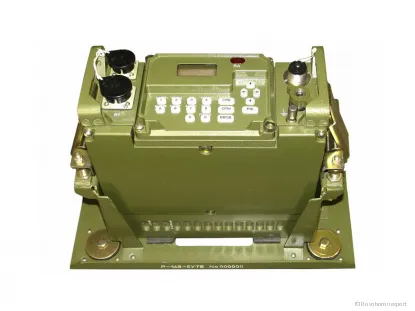The Russian Military Radio That’s Not So Russian
Captain Yaroslav Kalinin, CEO of the Ukrainian company Infozahyst LLC, provided an interesting breakdown of the Russian R-168 Akveduk software-defined radio, which began development in the early 2000s and was used for combat in Georgia in 2008. Ukrainian troops began intercepting the radio early in the war, allowing companies such as Infozahyst to conduct analysis in support of the Ukrainian armed forces.
The information found in the analysis of the captured equipment plays a direct role in supporting the defense of Ukraine. Rosoboronexport, Russia’s state arms exporter, bills the R-168 as “designed to provide communication in command and control networks at the regiment-battalion-company level,” making it important for the Ukrainian military to intercept, jam or degrade.
The radio performs “frequency hopping”, which is a method of avoiding jamming first pioneered by the US and notably by Hollywood actress Hedy Lamarr. Despite its anti-jamming capabilities, there are ways to “attack” this system.
Captain Kalinin describes various methods of jamming or intercepting signals generated by the R-168. The four main possible ways of connecting this system were thus outlined; Flash dump, logic signal analysis, bug attack and RF transmission capture. Andrew Dardin, head of electronics at Forecast International, said that “definitely the Ukrainians are also primed for jamming. They have been preparing for this for years.”
That being said, since this is a software-defined system, updates are likely to come in the near future. The problem the Russians may face is not the software but the hardware in the R-168.
Demolition of captured equipment also provides some interesting details about the origins of the parts. Of particular note is the fact that some of the main components of the R-168 radio are Western parts, Kalinin emphasized. The radios include components from Xilinx and its company AMD, Texas Instruments, Analog Devices and Renesas Electronics.
Dismantling captured systems allows the West to tighten its sanctions regime, especially since Russia still appears to be finding ways around restrictions and acquiring Western microelectronics. A June 2023 study by the KSE Institute and the International Working Group on Russian Sanctions found that Russian imports of critical components “recovered weeks after the initial decline immediately following the imposition of sanctions.”
Kalinin pointed out that Russia is upgrading its equipment, including the R-168, in part to address battlefield vulnerabilities. Given the large number of systems using imported components – and shortcomings in Russia’s domestic chip industry – it is likely that the Russian military will still remain somewhat dependent on imports of key microelectronics from abroad, underscoring the enduring importance of the sanctions regime for squeezing Russian military capabilities.
(This article was first published on Forecast International Defense and security monitor blog.)
-finishes-


Comments are closed.